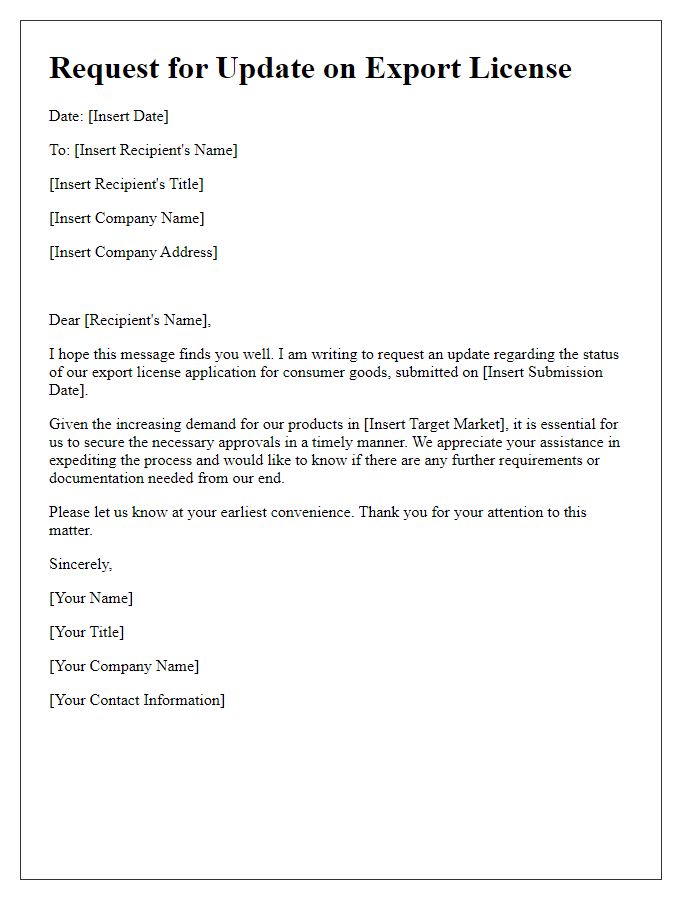Are you looking to navigate the often complex world of export licensing? Crafting the perfect application letter is essential, and it can greatly influence the success of your request. With a clear structure and concise language, you can effectively communicate your intentions to the relevant authorities. Curious about the best practices and helpful tips for writing this crucial document? Keep reading to discover a comprehensive guide!

Applicant Information
The export license application requires detailed applicant information to ensure compliance with international trade regulations. This includes the full legal name of the applicant company, which must be registered with relevant authorities, such as the Secretary of State in the United States. The company's address, often a corporate headquarters located at a specific street address in a recognized city, is essential for verification. Tax Identification Number (TIN) or Employer Identification Number (EIN) is also necessary for financial and tax purposes, while contact information, including phone numbers and email addresses, facilitates communication with licensing authorities. Information about the applicant's industry sector, such as manufacturing or technology, along with descriptions of products to be exported, should be provided clearly to assist in the evaluation process.
Product Description and HS Code
The export application process requires a detailed product description for compliance with international trade regulations. Products such as electronic components, including capacitors and resistors, fall under specific harmonized system (HS) codes that categorize goods for tariff purposes. For example, a multilayer ceramic capacitor might be classified under HS Code 8532, which pertains to electronic capacitors. Additionally, physical characteristics, such as size (measured in millimeters) and voltage rating (typically in volts), should be included for accurate classification. The precise and accurate documentation assists customs authorities in identifying products, ensuring compliance with export laws from the exporting country and applicable regulations in the importing country. Accurate HS codes help avoid delays at borders, facilitating smoother trade operations.
Destination Country and Importer Details
An export license application includes several critical sections, notably the destination country and importer details. For country information, including names (e.g., Canada, Japan, Germany), applicable regulations (such as the Export Control List, EAR, or ITAR compliance), and specific trade agreements relevant to exports (like NAFTA or EU regulations) is essential. Importer details require specific information, including the importer's business name, address, contact information, and customs identification number or tax ID. Additionally, including the intended use of imported goods, such as for manufacturing or resale purposes, provides a comprehensive understanding of the transaction. Proper documentation and accuracy ensure compliance and streamline the approval process by regulatory authorities.
Compliance with Export Regulations
The process of obtaining an export license involves rigorous adherence to governmental regulations, particularly the Export Administration Regulations (EAR) set forth by the Bureau of Industry and Security (BIS) in the United States. Compliance requires the accurate classification of goods, typically using the Export Control Classification Number (ECCN), which specifies the level of control needed for specific items, technologies, or software. Additionally, businesses must conduct thorough end-use, end-user, and country of destination assessments to ensure that products do not contribute to proliferation, terrorism, or human rights violations. Engaging in due diligence involves consulting the Denied Persons List and Entity List, which includes individuals and organizations prohibited from receiving exports due to national security concerns. Completing the application form, typically the BIS 748P, necessitates detailed information about the exporter, the item description, and the intended export activities, ensuring an empowered approach to complying with export regulations as of October 2023.
Justification for Export and Usage
Export licenses are essential for facilitating international trade, particularly for sensitive items or controlled technologies. The United States Department of Commerce maintains strict regulations under the Export Administration Regulations (EAR) to prevent unauthorized exportation of dual-use items, which can be utilized for both civilian and military applications. Justifications may include specific project details, such as contracts or agreements with foreign entities, detailed descriptions of the products or technologies, and their intended use. Furthermore, identifying end-users and end-uses, especially in locations like China, Russia, or Iran, is crucial for compliance. Supporting documentation, such as information regarding product functionality and compliance with safety standards, strengthens the application. Comprehensive risk assessments demonstrating a commitment to responsible trading practices further enhance the justification for an export license.
Letter Template For Export License Application Samples
Letter template of follow-up on export license application for chemicals.

Letter template of update request for export license for consumer goods.

Letter template of confirmation for export license application for automotive parts.











Comments